March 27, 2006
JUNGLE PATROL
Take care, people.
This blogpost has the capacity to take you down a GIGANTIC FILIPINO WORMHOLE!
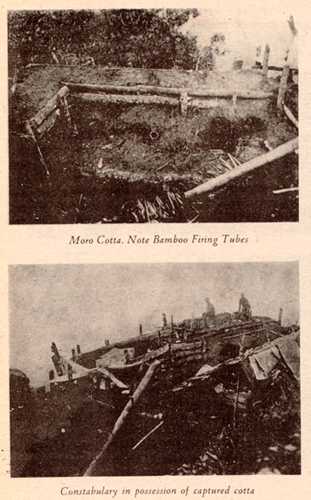
The year 1906. . . .Commanding officer's quarters at Pettit Barracks, Zamboanga.
General Leonard Wood penning a note to Colonel J. W. Duncan of the American assault forces. "I wish you would get two of your companies together and go to Jolo at once. Nothing but blanket rolls, field mess outfit, seven days' field rations and two hundred rounds per man. In haste. Regular orders will reach you later."
The storming of the cottas on Bud Dajo . . .
Up the steep sides of the mountain, American soldiers advance against the frowning cottas, garrisoned with 1,000 armed Moros. Nine hundred and ninety-four Moros fall before the Gatling guns of the twentieth century. The trenches are piled high with the slain. Kris against Gatling gun. Spear against mountain artillery.
Civilization marches on. . . .
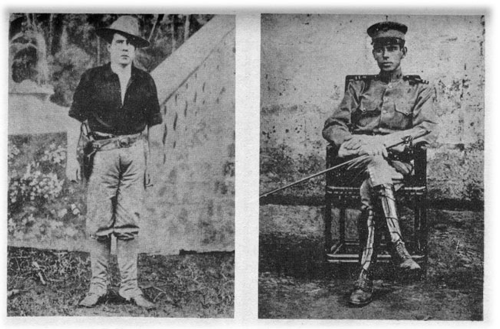
About three months before Wretchard of the great GWOT analysis blog Belmont Club had flagged the website featuring Jungle Patrol (please read his introduction to Victor Hurley's Jungle Patrol, it is superior to what I can do here), I surfed into it over the past Winter holiday. I have always been searching for the nature of my mixed heritage. While we are awash here in the States in information regarding our nature as Americans (North Americans, Yanks), there is precious little to be found regarding the Filipino people.
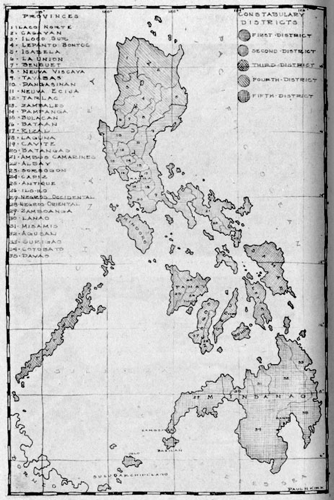
(Note: For those of you who don't yet know, I am heterogenaic. My father was born in Texas and raised in Missouri; my mother was born in Quezon City, and raised partly in Manila and in Madrid. I was born in Madrid when my folks met there many moons ago. I'm a half breed, a mestizo, a member of the mongrel race and proud of it.)
I used to go to cultural center in Manila when I was a kid sailor on leave and I remember coming away with little to edify me as to who were the Filipinos before the colonialization of the USA or of Spain. The CIA FactBook lists the ethnic breakdown this way:
Tagalog 28.1%, Cebuano 13.1%, Ilocano 9%, Bisaya/Binisaya 7.6%, Hiligaynon Ilonggo 7.5%, Bikol 6%, Waray 3.4%, other 25.3% (2000 census)Or another way to see the bewildering diversity of the Filipinos is to count the languages: asdie from Tagolog and English, there are eight other dialects.
Later in the early days of our life here in LA, I met a friend of Manuel Ocampo at a cafe in SilverLake. Filipino and a man of years as apparent wisdom, i asked him the question that has been on my mind for most of my life: Who are the Filipinos before the Spanish and the Americans? He told me in sage tones, nodding: "They are a noble race, a very noble race."
Not much help there.
Enter Bakbakan, a Filipino martial arts site:The religious, spiritual and fraternal heritage of the Philippines is evident in the symbols and rites adopted and practiced by Bakbakan International. The values and principles of Bakbakan International, following traditional, regional and Katipunan conventions, are evident in the ritual order in which members pledge their allegiance, loyalty and obedience to God, to country, and to the brotherhood.
What's supercool is that this site features two books that get to the cultural roots issue through links like these: (scroll down on the left margin toward the Histtorical Features category) "The Burning of Samar", "Andres Bonifacio", "Captain Leonard Furlong" (a movie should be made of this guy), "Swish of the Kris" (kris is a type of fighting blade), and the one featured here in this blogpost, ""Jungle Patrol".
What follows are snippets for your perusing pleasure. From Chapter 13, "Mohammedans". Teh point of my post titled "1786" is to say that this Global War on Terror is not new, that it has been with us (USA us) since the founding of our country, and with civilization since we have had one (dates of origin vary). Here in "Jungle Patrol", one might see these roots in the Philippine-American War.
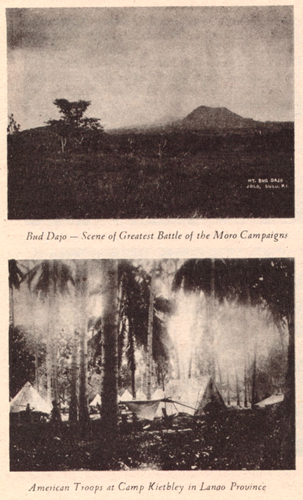
In the vicinity of Zamboanga, the Constabulary was com posed of equal portions of Moros and Christian Filipinos. It was necessary to establish separate messes in each company, as the Moros were forbidden by the Koran to eat pork. This ban prohibited the old army stand-by of pork and beans, as well as the issue of hardtack, which contained lard as an ingredient.The Moros came slowly to the Constabulary. By the end of 1903, one hundred and two of the Mohammedans had been enlisted.
The greatest problem of the authorities was that question of the feasibility of arming these wild Mohammedans with rifles. The Moro youth purchases his bride, or brides, from the father-in-law, the desirability of the maidens influencing the purchase price. It was pointed out that a rifle was an object almost worth its weight in gold in the interior mountains, and that many young Moros might enlist with the idea of prompt desertions with their arms
But the Moro has a peculiar, inflexible code; once he became accustomed to military discipline, he proved a loyal soldier, and desertions were almost zero in the force after organization was complete. Captain Harbord deserves great credit for the tact with which he explored this dangerous possibility.
Harbord made an effort to understand Moros, and he learned many things about these strange grim men.He discovered that to change officers too often was to affect discipline. The Moros made a personality out or their officer; if he was brave and fair, they idolized him for those two prime virtues. Officers had to be especially strong in those qualities of leadership and valor.
Behind that type of officer, the Moros would go smiling and happy to their deaths.
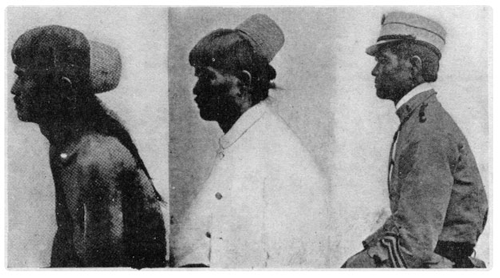
***
On Basilian Island, a station was established at Isabela. Here, Captain Sandford, with 49 men, occupied the old Spanish fort that was a relic of the unsuccessful days of the conquistadores. On clear days Sandford could almost look into the bastions of the old fortress of Senora del Pilar at Zamboanga, fifteen miles away.In Cotabato Province, 95 men under Captain Long were occupying stations at Cotabato, Libungan, Tumao, and Taviran. To this sector came two raw young officers who were extremes in temperament, nationality, and appearance. Lieutenant Gilheuser was one, a big blond German, fresh from the Prussian army.
The other was a slim, dark American boy, very carefully groomed and sporting a tiny mustache. As one considered his slight frame and slender wrists, he seemed ill-adapted for service in this organization of rough fighting men who took jungle in their stride.
But he was to develop--in the opinion of many--into the greatest warrior of them all. His name was Leonard Furlong. His short, wild life must have been an unhappy one. There could have been no other reason for that dashing, frenzied career of battle that he waged in Mindanao.
Twenty years after Furlong had fired his last shot, this writer stood with wrinkled and ancient Moros on the sites of some of the Cotabato battles of this Captain of Constabulary. We talked, the Moros and I, of those old days of murder and piracy and ambush, when the kris had been the law and the measure of a man. The Moros are always ready to talk of battle.
These scarred old reprobates with blackened teeth and betel-stained lips, were no exception. Our conversation that day was filled with grand names: Allan Fletcher of the Scouts, called "Papa" by Moro and Filipino and American--a grand campaigner; Lieutenant Whitney of the prodigious strength gained a shuffle of bare feet and the twitch of a turban; then we talked of a Lieutenant named Cochrun--"a brave man, si," was his accolade; a youngster's name came into the conversation--Jesse Tiffany. The Moros fought him on their cotta walls. He, too, was valiant--a nod of the turbans confirmed him with the greatest praise a Moro can bestow on a man.
But when I mentioned Furlong, a glisten came into the eyes of ancient Moros who talk of redder and grander days. They sent up the most impressive salute to Valhalla that I can ever hope to witness. I see them now as I write--a circle of genial old ruffians, almost ready themselves to mount a white horse to Paradise. Their turbans are off now and their chins at rest on their scarred and brawny chests. After twenty years, they bend a neck to the memory of Leonard Furlong--"most desperate fighting man of all."
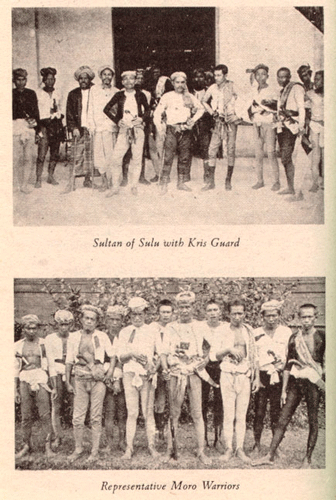
***
No visitor to the southern islands can remain long unaware of the brooding presence of the old forts of Spain. They were abodes of horror in the old days, and they seem to retain those memories of retching death on the kris. These great thick walls and towering bastions were a gesture of futility--a gesture of the Spanish occupation of Moroland.The Spanish fought a waiting war against the Moros. Their indecision developed into the most lengthy wait of history. For almost four centuries they cowered behind walls of stone. The Spaniards took up the Moro wars with a great confidence and a brave flutter of pennons. They dropped the conquest with a feeling of apathy and stark fear.
Only in Mindanao, of all the world, did the Spaniard of the looting age fail to make conquest. There, the conquistadores met men who considered warfare one of the major pleasures of an otherwise drab existence. They met Malays who struck with ferocity and withdrew silently through the tall grass. They met men who were inspired by a major defeat, and who deliberately prolonged the warfare for the sheer joy of fighting.
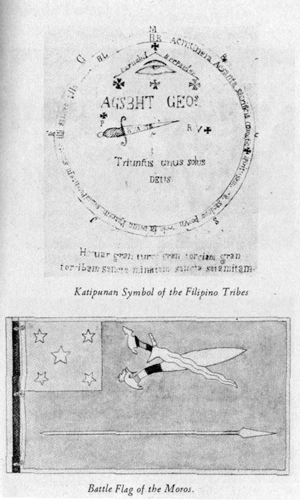
***
This snip is from the "Swish of the Kris":
Mohammedan conquests from Arabia reached India and Sumatra about AD 700. Thence the religion spread slowly across the Netherlands East Indies to envelop all of the islands of the East Indian Archipelago. Sumatra was converted by 1200, and Java came under the influence of Islam by 1500.It appears that in the year 1380 the first Mohammedan missionary, a noted Arabian judge named Makdum introduced the religion to the Philippines. The ruins of the mosque he built at Tubig-Indangan on the island of Simunul are still to be seen.
Later, about 1400, the Rajah Baguinda continued the work of Makdum. The remarkable campaign of this missioner ended on Sibutu Island where he lies buried today in the village of Tandu-Banak. The work of Baguinda appears to have been confined to the islands of the Sulu Archipelago. To Shereef Kabungsuwan is credited the conversion of Mindanao.
The followers of Mohammed were zealous in spreading the faith. They conquered Asia Minor and Africa. Then the robed priests entered Europe, first by way of Spain and through the Red Sea southward to Madagascar and eastward to India. No hardship was too great, no people too savage. From India, the Star and Crescent were carried to the Malay Archipelago. A Mohammedan settlement was established in Borneo as early as 1400, and Malacca was penetrated in 1276. The Portuguese Moluccas was converted by 1456.
The early Mohammedan missionaries were a sturdy lot. They came into raw countries without ships or armies or governments to back them. They must be numbered among the most sincere disciples that any religious faith has produced. They sought nothing but the privilege of converting the unbeliever. Gold they wanted not. Trade routes were not the object of their search. They came alone into the heart of one of the most savage countries on the globe, buoyed high by a faith which protected them well.
They had all the fanaticism of the Spanish priests without the accompanying greed for gold. They were the most purely altruistic preachers in the world. Their utter sincerity inspired the confidence of their savage hosts. The priests of Mohammed were among the most potent spreaders of civilization in the history of man. Their religion did not tear down and strip and destroy as that of the early Christians. The priests of Mohammed brought culture and writing and the arts, and they added these things to the culture they found in their new lands. They were not destroyers, but were satisfied to improve the old culture.
And so to the island of Simunul came the missionary Makdum in 1380, to land unarmed and unafraid in the group of brown krismen who came down the strip of white beach to meet him. The Moros were puzzled and in awe of this man who came unannounced among them, asking nothing but the privilege of being heard. The iron of the Koran had arrived to fortify the souls of the Moros.
Through the islands spread the word of the man who told of the true God and of the warriors slain on the field of battle, reclining on damask couches with houris with "large black eyes."1
POSTSCRIPT: Rereading this post, I have a second thought about the characterization of Jungle Patrol and the Philippine-American War as a solitary index to the character of Filipinos. The culture described here is Moro, something I know little about (familialy or otherwise) first hand. There is something about the tribal legacy that infuses the many islands of the Philippines... but ultimately this is too ephemeral for use as a cultural marker for what I am seeking.
Therefore, I keep on seeking....
Posted by Dennis at March 27, 2006 1:36 PM
Leave a comment